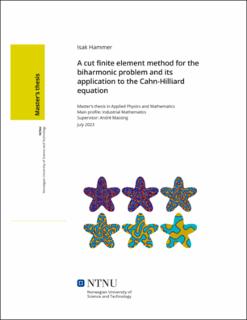| dc.contributor.advisor | André Massing | |
| dc.contributor.author | Isak Hammer | |
| dc.date.accessioned | 2023-10-31T18:19:58Z | |
| dc.date.available | 2023-10-31T18:19:58Z | |
| dc.date.issued | 2023 | |
| dc.identifier | no.ntnu:inspera:140649151:33393388 | |
| dc.identifier.uri | https://hdl.handle.net/11250/3099854 | |
| dc.description.abstract | Cahn-Hilliard-ligningen har et bredt av anvendelser innen fase-separasjon, men gir numeriske utfordringer på grunn av sin ikke-linearitet, stivhet og fjerdeordens deriverte. I denne avhandlingen introduserer vi en ny og stabilisert cut continuous interior penalty finite element metode spesifikt utviklet for det biharmoniske problemet med Cahn-Hilliard-liknende randbetingelser, og deretter utvidet for å håndtere Cahn-Hilliard-ligningen. Ideen er å anvende det teoretiske rammeverket for cut discontinuous Galerkin metoden for Poisson problemet, slik det er foreslått av [1], i kombinasjon med analysen av continious interioir penalty metoden for det biharmoniske problemet presentert av [2,3]. Vi deretter gir teoretisk grunnlag for at denne metoden er veldefinert og har optimal konvergens. Videre validerer vi de teoretiske resultatene med numeriske eksperimenter. Til slutt demonstrerer vi at metoden kan bli utvided til å håndtere Cahn-Hilliard-ligningen ved hjelp av en minimalistisk Implisitt-Eksplisitt (IMEX) tidsdiskretiseringsmetode for å håndtere ikke-lineariteter. | |
| dc.description.abstract | The Cahn-Hilliard equation, with its wide range of applications in phase-separation, poses numerical challenges due to its non-linear and stiff nature and fourth-order derivatives. This thesis introduces a novel, stabilized, unfitted cut continuous interior penalty finite element method specifically designed for the biharmonic problem with Cahn-Hilliard type boundary conditions, which we have successfully extended to handle the Cahn-Hilliard equation. Our approach combines the theoretical cut discontinuous Galerkin framework for the Poisson problem, as proposed by [1], with the continuous interior penalty biharmonic formulation presented by [2,3]. We prove that this method is well-posed and ensures optimal convergence. The theoretical results are further supported by presented numerical evidence. Finally, we demonstrate the applicability of the method by extending the formulation to handle the Cahn-Hilliard equation using a minimalistic Implicit-Explicit (IMEX) time discretization scheme to manage the non-linearities. | |
| dc.language | eng | |
| dc.publisher | NTNU | |
| dc.title | A cut finite element method for the biharmonic problem and its application to the Cahn-Hilliard equation | |
| dc.type | Master thesis | |
